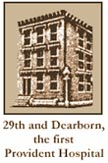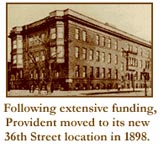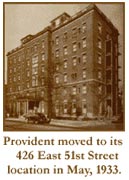History - Provident Hospital
In 1889, Emma Reynolds, a young woman who aspired to be a nurse, was denied admission by each of Chicago's nursing schools on the grounds that she was black. Her brother, the Reverend Louis Reynolds, pastor of St. Stephen's African Methodist Episcopal Church, approached the respected black surgeon, Dr. Daniel Hale Williams for help. Unable to influence the existing schools, they decided to launch a new nursing school for black women. In 1890, Dr. Williams consulted with a group of black ministers, physicians and businessmen to explore establishing a nurse-training facility and hospital. There were only a few black physicians in Chicago at this time, and all had limited or no hospital privileges. The community leaders assured him of their support and energetic fund-raising began.
 With the help of a few prominent white citizens as well as many black individuals and organizations, donations were collected. Rallies were scheduled on Chicago's south and west sides. The donations included supplies, equipment, and financial support. One of the most important early contributions came in 1890 when clergyman Reverend Jenkins Jones secured a commitment from the Armour Meat Packing Company for the down payment on a three-story brick house at 29th and Dearborn. This building, with 12 beds, became the first Provident Hospital.
With the help of a few prominent white citizens as well as many black individuals and organizations, donations were collected. Rallies were scheduled on Chicago's south and west sides. The donations included supplies, equipment, and financial support. One of the most important early contributions came in 1890 when clergyman Reverend Jenkins Jones secured a commitment from the Armour Meat Packing Company for the down payment on a three-story brick house at 29th and Dearborn. This building, with 12 beds, became the first Provident Hospital.
Although the Hospital's formation was dependent on wealthy donors, and affluent donors stepped in at key moments in Provident's history, the generosity of community residents was also a critical factor. Community support was not restricted to financial contributions. The strong appeal of a hospital responsive to the black community elicited repeated waves of community volunteerism. Black residents, workers, employers, public officials, church leaders, and civic leaders contributed heavily to opening and sustaining the facility.
The initial priority was to secure an adequate hospital building. But the founders also considered community needs, the initial scope of services and the Hospital's overall mission. The legal papers were drawn up in 1891 for "Provident Hospital and Training School Association" and the charter stated: "The object for which it is formed is to maintain a hospital and training school for nurses in the City of Chicago, Illinois, for the gratuitous treatment of the medical and surgical diseases of the sick poor."
In 1891, a board of trustees, an executive committee, and a finance committee were named and a community advisory board and women's auxiliary board were assembled. The Hospital's first annual budget totaled $5,429. By the end of the year, Provident Hospital was designated an Illinois corporation, the training school for nurses opened and Dr. Williams was appointed hospital chief-of-staff. By 1892,seven women, including Emma Reynolds, had enrolled in the first nursing class. Provident was established to serve all races, and its patients and physicians were black and white during early years. The first physicians in surgical training, Dr. Austin Curtis, received two years of instruction under Dr. Williams, from 1891 through 1893. (Dr. Curtis became the first black surgeon-in-chief at Freedmen's Hospital in Washington, D.C.)
Like any institution that endures for a century, Provident experienced many changes in its medical and administrative leadership. In 1894, Dr. Williams moved to Washington, D.C., where he was named surgeon-in-chief of Freedmen's Hospital. During this period, there were discussions on physician practice issues and the trustees were sharply divided as to whether physicians could hold medical appointments at other hospitals. Dr. George Cleveland Hall, an opponent of Dr. Williams, was named medical director and his supporters assumed control of Provident's trustee board.
 As the demand for medical care grew, the Provident board initiated planning to expand. An 1896 funding campaign raised sufficient funding to construct a new building on donated land at 36th and Dearborn. The effort was helped by abolitionist Frederick Douglass, who gave a public lecture in Chicago and presented a donation at the Hospital site to Dr. Williams. By 1897, the Hospital had 189 inpatients, and the outpatient clinic, the Armour Dispensary, treated approximately 6,000 patients. In 1898, the Hospital moved to the new 36th Street location, which had 65 beds.
As the demand for medical care grew, the Provident board initiated planning to expand. An 1896 funding campaign raised sufficient funding to construct a new building on donated land at 36th and Dearborn. The effort was helped by abolitionist Frederick Douglass, who gave a public lecture in Chicago and presented a donation at the Hospital site to Dr. Williams. By 1897, the Hospital had 189 inpatients, and the outpatient clinic, the Armour Dispensary, treated approximately 6,000 patients. In 1898, the Hospital moved to the new 36th Street location, which had 65 beds.
A controversial educational affiliation with the University of Chicago came about in 1933. As part of the agreement, Provident purchased a building at 426 East 51st Street, previously occupied by the Chicago Lying-in Hospital. The newly refurbished, seven story facility added considerable space for patient care, education, and administrative functions. A four-story outpatient building was constructed and two apartment buildings at 50th and Vincennes were purchased to house student nurses. As evidence of its support, the University of Chicago established a one million dollar fund for teaching and research at Provident Hospital.

Provident had two final major financial crisis, one in the late 40's that was narrowly averted and one in the mid 80's. Increasing debt led to a series of efforts to sustain Provident, including developing an alliance with Cook County Hospital, and other public and private financing plans. None of these efforts were successful and the hospital declared bankruptcy in July 1987. Provident Hospital closed its doors in September 1987
The interest in reopening Provident Hospital remained a priority for many. Community groups and others tried to raise both funding and political support to reopen the hospital. These efforts were not successful. However, the long-standing interest of Cook County Hospital in Provident Hospital led the Cook County Board of Commissioners to acquire the hospital in 1991.
This coincided with the County's Bureau of Health Services' plan to improve service provision to County residents living on the south side of Chicago. After considerable investment in upgrading the physical plant, the Bureau reopened Provident Hospital in August 1993. The Hospital's traditional medical education role was reestablished in 1994 through an educational affiliation with Loyola University's Stritch School of Medicine. While no longer considered a black-run hospital, Provident continues to serve the health needs of the community, including a variety of health outreach efforts.
